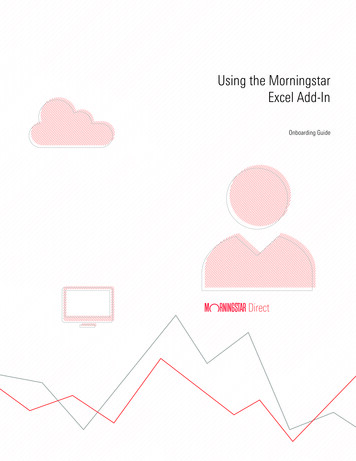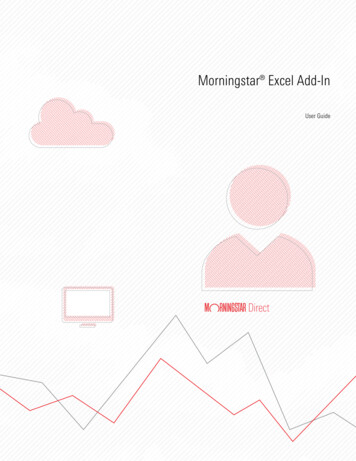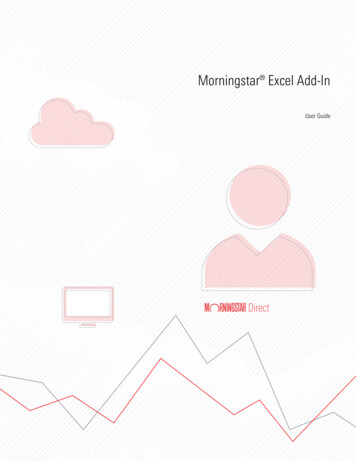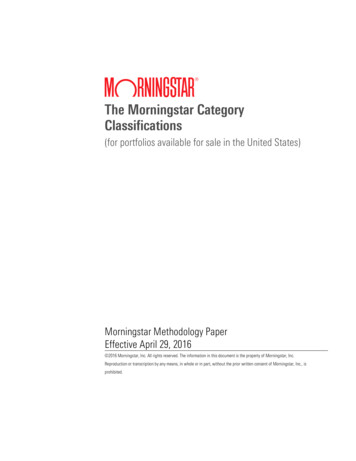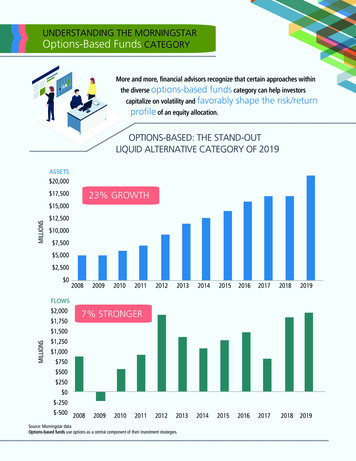
Transcription
Morningstar, Inc. Global Equity Data FundamentalsConfidentialGlobal Equity DataUser’s ationRaw FundamentalsIncome StatementBalance SheetCash FlowTTMPrice/ReturnsAlpha/BetaStatisticsCurrency ExchangeCorporate CalendarOwnership/Short InterestOwnership DetailInsider Trading ActivitiesCorporate ActionsExecutive InsightConsensus RecommendationsConsensus EstimatesSay on PayVoting ReportQuestions: 1-800-775-8118 or globalequitydatasupport@morningstar.compage 2page 4page 6page 10page 15page 17page 38page 66page 84page 85page 88page 89page 90page 91page 91page 93page 94page 95page 96page 101page 102page 109page 1091
Morningstar, Inc. Global Equity Data FundamentalsConfidentialOperationalCompanyId (1)10-digit unique and unchanging Morningstar identifier assigned to every company.ShortName (2)25-character max abbreviated name of the firm. In most cases, the short name will simply be the Legal Name less the“Corporation”, “Corp.”, “Inc.”, “Incorporated”, etc StandardName (3)The English translation of the foreign legal name if/when applicable.LegalName (4)The full name of the registrant as specified in its charter, and most often found on the front cover of the 10K/10Q/20F filing.CountryId (5)3 Character ISO code of the country where the firm is domiciled. See separate reference document for Country Mappings.CIK (6)The Central Index Key; a corporate identifier assigned by the Securities and Exchange Commission (SEC).CompanyStatus (9)At the Company level; each company is assigned to 1 of 3 possible status classifications; (U) Public, (V) Private, or (O) Obsolete: Public-Firm is operating and currently has at least one common share class that is currently trading on a public exchange. Private-Firm is operating but does not have any common share classes currently trading on a public exchange. Obsolete-Firm is no longer operating because it closed its business, or was acquired.FiscalYearEnd (10)The Month of the company’s latest fiscal year.IndustryTemplateCode (11)This indicator will denote which one of the six industry data collection templates applies to the company. Each industry datacollection template includes data elements that are commonly reported by companies in that industry. N Normal(Manufacturing), M Mining, U Utility, T Transportation, B Bank, I InsurancePrimaryShareClassID (12)The 10-digit unique and unchanging Morningstar identifier assigned to the Primary Share class of a company. The primary share ofa company is defined as the first share that was traded publicly and is still actively trading. If this share is no longer trading, theprimary share will be the share with the highest volume.PrimarySymbol (13)The symbol of the Primary Share of the company, composed of an arrangement of characters (often letters) representing aparticular security listed on an exchange or otherwise traded publicly. The primary share of a company is defined as the first sharethat was traded publicly and is still actively trading. If this share is no longer trading, the primary share will be the share with thehighest volume. Note: Morningstar’s multi-share class symbols will often contain a “period” within the symbol; e.g. BRK.B forBerkshire Hathaway Class B.Questions: 1-800-775-8118 or globalequitydatasupport@morningstar.com2
Morningstar, Inc. Global Equity Data FundamentalsConfidentialPrimaryExchangeID (14)The Id representing the stock exchange of the Primary Share of the company. See separate reference document for ExchangeMappings. The primary share of a company is defined as the first share that was traded publicly with and is still actively trading. Ifthis share is no longer trading, the primary share will be the share with the highest volume.BusinessCountryID (15)In some cases, different from the country of domicile (CountryId; DataID 5). This element is a three (3) Character ISO code of thebusiness country of the security. It is determined by a few factors, including: Country of incorporationCountry of primary headquartersCountry of primary exchange listingCountry of most significant trading volumesGeographic source of revenues and location of assetsLegalNameLanguageCode (16)The language code for the foreign legal name if/when applicable. Related to DataID 4 (LegalName).ShareClassId (1000)10-digit unique and unchanging Morningstar identifier assigned to each distinct share class of a company.Symbol (1001)An arrangement of characters (often letters) representing a particular security listed on an exchange or otherwise traded publicly.Note: Morningstar’s multi-share class symbols will often contain a “period” within the symbol; e.g. BRK.B for Berkshire HathawayClass B.ExchangeId (1002)The Id representing the stock exchange that the particular share class is trading. See separate reference document for ExchangeMappings.ExchangeSubMarketId (1003)The Id representing the stock exchange sub market that the particular share class is trading. See separate reference document forExchange Mappings.CurrencyId (1004)3 Character ISO code of the currency that the exchange price is denominated in; i.e. the trading currency of the security. Seeseparate reference document for Currency Mappings.Valoren (1005)An identification number assigned to financial instruments in Switzerland. These numbers are similar to the CUSIP numbers that areused in Canada and the U.S. A typical valoren number is between six to nine digits in length.CUSIP (1006)The acronym for the Committee for Uniform Security Identification Procedures. The Committee is appointed by the NationalAssociation of Securities Dealers (NASD) to assign identification numbers to nearly all publicly traded stock and bond certificates.CUSIPs are 9-digit numbers designed to be unique numerical identifiers for traded securities.NOTE: CUSIPS are proprietary to Standard & Poor’s CUSIP Service Bureau through an exclusive agreement with American BankersQuestions: 1-800-775-8118 or globalequitydatasupport@morningstar.com3
Morningstar, Inc. Global Equity Data FundamentalsConfidentialAssociation. CUSIP number is provided for matching purposes only; no redistribution rights apply.ISIN (1007)The acronym for International Securities Identification Number. A code that uniquely identifies a specific securities issue. Theorganization that allocates ISINs in any particular country is the country's respective National Numbering Agency (NNA). Allinternationally traded securities issuers are urged to use this numbering scheme, which is now the accepted standard by virtuallyall countries. The United States and Canada primarily use a similar scheme known as a CUSIP number.SEDOL (1008)The acronym for Stock Exchange Daily Official List. An identification code, consisting of at least seven alphanumeric characters,that is assigned to all securities trading on the London Stock Exchange and on other smaller exchanges in the U.K .U.K. stocksthat do not trade in the U.S. can be identified by their SEDOL code.IPODate (1009)The initial day that the share begins trading on a public exchange.IsDepositoryReceipt (1010)Indicator to denote if the share class is a depository receipt. 1 denotes it is an ADR or GDR; otherwise 0.DepositoryReceiptRatio (1011)The number of underlying common shares backing each American Depository Receipt traded.SecurityType (1012)Each security will be assigned to one of the below security type classifications; Common Stock (ST00000001) Preferred Stock (ST00000002)ShareClassDescription (1013)Provides information when applicable such as whether the share class is Class A or Class B, an ADR, GDR, or a businessdevelopment company (BDC). For preferred stocks, this field provides more detail about the preferred share class.ShareClassStatus (1014)At the ShareClass level; each share is assigned to 1 of 4 possible status classifications; (A) Active, (D) Deactive, (I) Inactive, or (O)Obsolete: Active-Share class is currently trading in a public market, and we have fundamental data available. Deactive-Share class was once Active, but is no longer trading due to share being delisted from the exchange. Inactive-Share class is currently trading in a public market, but no fundamental data is available. Obsolete-Share class was once Inactive, but is no longer trading due to share being delisted from the exchange.IsPrimaryShare (1015)This indicator will denote if the indicated share is the primary share for the company. A “1” denotes the primary share, a “0”denotes a share that is not the primary share. The primary share is defined as the first share that a company IPO’d with and is stillactively trading. If this share is no longer trading, we will denote the primary share as the share with the highest volume.IsDividendReinvest (1016)Shareholder election plan to re-invest cash dividend into additional shares.IsDirectInvest (1017)A plan to make it possible for individual investors to invest in public companies without going through a stock broker.Questions: 1-800-775-8118 or globalequitydatasupport@morningstar.com4
Morningstar, Inc. Global Equity Data FundamentalsConfidentialInvestmentId (1018)Identifier assigned to each security Morningstar covers.P rofileShort(Business)Description (2000)A brief business description of the company; often using abbreviated words and may not be a full sentence(max 200 characters)Medium(Business)Description (2001)A more complete business description of the company; often a sentence or two.(max 1000 characters)Long(Business)Description (2002)A complete and often lengthy business description of the company; often a paragraph or more.(no max )HeadquarterAddressLine1 (2100)The headquarter address as given in the latest reportHeadquarterAddressLine2 (2101)The headquarter address as given in the latest reportHeadquarterAddressLine3 (2102)The headquarter address as given in the latest reportHeadquarterAddressLine4 (2103)The headquarter address as given in the latest reportHeadquarterAddressLine5 (2104)The headquarter address as given in the latest reportHeadquarterCity (2105)The headquarter city as given in the latest reportHeadquarterProvince (2106)The headquarter state or province as given in the latest reportHeadquarterCountry (2107)The headquarter country as given in the latest reportHeadquarterPostalCode (2108)The headquarter postal code as given in the latest reportHeadquarterPhone (2109)The headquarter phone number as given in the latest reportQuestions: 1-800-775-8118 or globalequitydatasupport@morningstar.com5
Morningstar, Inc. Global Equity Data FundamentalsConfidentialHeadquarterFax (2110)The headquarter fax number as given in the latest reportHeadquarterHomepage (2111)The headquarter’s website address as given in the latest reportTotalEmployeeNumber (2113)The number of employees as indicated on the latest Annual Report, 10-K filing, Form 20-F or equivalent report indicating theemployee count at the end of latest fiscal year.ContactEmail (2114)Company’s contact email addressSharesOutstanding (40000)The latest total shares outstanding reported by the company; most common source of this information is from the cover of the10K, 10Q, or 20F filing. This figure is an aggregated shares outstanding number for a company. It can be used to calculate the mostaccurate market cap, based on each individual share’s trading price and the total aggregated shares outstanding figure.MarketCap (40001)Price * Total SharesOutstanding.The most current market cap for example, would be the most recent closing price x the most recent reported shares outstanding.For ADR share classes, market cap is price * (ordinary shares outstanding / adr ratio).EnterpriseValue (40002)This number tells you what cash return you would get if you bought the entire company, including its debt.Enterprise Value Market Cap Preferred stock Long-Term Debt And Capital Lease Short Term Debt And Capital Lease Securities Sold ButNot Yet Repurchased - Cash, Cash Equivalent And Market Securities - Securities Purchased with Agreement to Resell - g (40003)The latest shares outstanding reported by the company of a particular share class; most common source of this information is fromthe cover of the 10K, 10Q, or 20F filing. This figure is an aggregated shares outstanding number for a particular share class of thecompany.P roprietaryStockType (3000)The purpose of the Stock Types is to group companies according to the underlying fundamentals of their business. They answer thequestion: If I buy this stock, what kind of company am I buying? Unlike the style box, the emphasis with the Stock Types is onincome statement, balance sheet, and cash-flow data—not price data or valuation multiples. We focus on the company, not thestock. Morningstar calculates this figure in-house on a monthly basis.Investors can use the Stock Types to diversify portfolios across a variety of different kinds of companies. They can also use theStock Types as a benchmark for comparing the performance of any one company against the performance of similar companies.Finally, in analyzing companies in different Stock Types, different questions become important. For Cyclicals, how did the companyQuestions: 1-800-775-8118 or globalequitydatasupport@morningstar.com6
Morningstar, Inc. Global Equity Data FundamentalsConfidentialdo during the last recession? For High Yield, how dependable is the company’s dividend? For Speculative Growth, how much cashdoes the company have to spend to generate its rapid revenue growth?We divide the universe into eight Stock Types. There’s nothing magical about eight; we simply broke out companies the way wetend to think about them when analyzing them. (There are some stocks that don’t have enough data to assign a Stock Type. Theseare labeled N/A.) Also, a stock may meet the conditions for more than one Stock Type. We designed the algorithm, however, sothat it will assign only one Stock Type per stock—the Stock Type we feel is most appropriate.The 8 stock types are:Aggressive Growth-1: companies whose sales and earnings have grown very rapidly over the trailing five-year period. Thesefirms tend to be a step up the quality ladder from speculative-growth firms.Classic Growth-2: companies that show moderate to rapid growth over the trailing five-year period in two of the following threecategories: sales, earnings, dividends. These tend to be fairly mature firms, but ones that are still generating steady growth.Cyclicals-3: companies whose core business can be expected to fluctuate in line with the overall economy. In a boomingeconomy such companies will look excellent; in a recession, their growth stalls and they might even lose money.Distressed-4: companies that are having serious operating problems. This could mean declining cash flow, negative earnings, highdebt, or some combination of these. Such “turnaround” stocks tend to be highly risky, but also harbor some intriguing investments.Hard Asset-5: companies whose main business revolves around the ownership or exploitation of hard assets like real estate,metals, timber, etc. Such companies typically sport a low correlation with the overall stock market, and have traditionally beenwhere investors look for inflation hedges.High Yield-6: companies whose stocks offer a high dividend yield. These tend to be mature companies that choose not to reinvestthe bulk of their earnings. For investors interested in income, this is where to look.Slow Growth-7: companies that have grown slowly, if at all, over the trailing five-year period. These companies tend to be maturefirms.Speculative Growth-8: companies whose sales have grown very rapidly over the trailing five-year period, but whose earningsgrowth has been spotty. These tend to be companies in the early phase of their growth cycle.StyleBox (3001)The Morningstar Style Box captures three of the major considerations in equity investing: size, security valuation and securitygrowth. The Style Box is a nine-square grid that classifies securities by size along the vertical axis and by value and growthcharacteristics along the horizontal axis. It measures style exposure and is a great diversification tool. The grid format allowsinvestors to design equity portfolios that cover a wide spectrum of the market. A quick glance at the style box will indicate whetherthe stocks have small or large market capitalizations and whether they are more value-oriented or growth-oriented. Morningstarcalculates this figure in-house monthly based on data from the past five years.StylecodeStyle1234Large ValueLarge CoreLarge GrowthMid ValueQuestions: 1-800-775-8118 or globalequitydatasupport@morningstar.com7
Morningstar, Inc. Global Equity Data FundamentalsConfidential56789Mid CoreMid GrowthSmall ValueSmall CoreSmall GrowthGrades - The Morningstar stock-grading system is a quantitative scoring system that consists of three grades: Growth, Profitability,and Financial Health. They're meant to be a quick way to get a handle on a company's fundamentals. All grades are based onrelative rankings. For example, a company that receives an "A" in growth is a company that ranks near the top of our universe interms of growth. We award 10% of the universe As, 20% Bs, 40% Cs, 20% Ds, and 10% Fs. The grades are based solely on thenumbers reported by the company in its SEC filings. Due to accounting conventions, however, these grades may or may not reflectthe underlying economic reality, and investors should view the grades as a starting point for analysis rather than a definitivejudgment on the company. No Morningstar analyst makes a subjective call as to what grade a company should get. All informationused to calculate the grades comes from Morningstar's internal equities database.GrowthGrade (3002)The growth grade is based on the trend in revenue per share using data from the past five years. For the purpose of calculatingrevenue per share we use the past five years' revenue figures and corresponding year-end fully diluted shares outstanding; if yearend fully diluted shares outstanding is not available, we calculate this figure by dividing the company's reported net incomeapplicable to common shareholders by the reported fully diluted earnings per share. A company must have a minimum of fourconsecutive years of positive and non-zero revenue, including the latest fiscal year, to qualify for a grade.In calculating the revenue per share growth rate, we calculate the slope of the regression line of historical revenue per share. Wethen divide the slope of the regression line by the arithmetic average of historical revenue per share figures. The result of theregression is a normalized historical increase or decrease in the rate of growth for sales per share. We then calculate a z-score bysubtracting the universe mean revenue growth from the company's revenue growth, and dividing by the standard deviation of theuniverse's growth rates.Stocks are sorted based on the z-score of their revenue per share growth rate calculated above, from the most negative z-score tothe most positive z-score. Stocks are then ranked based on their z-score from 1 to the total number of qualified stocks. We assigngrades based on this ranking. Stocks are assigned A, B, C, D, or F. Morningstar calculates this figure in-house on a monthly basis.FinancialHealthGrade (3003)Instead of using accounting-based ratios to formulate a measure to reflect the financial health of a firm, we use structural orcontingent claim models. Structural models take advantage of both market information and accounting financial information. Thefirm's equity in such models is viewed as a call option on the value of the firm's assets. If the value of the assets is not sufficient tocover the firm's liabilities (the strike price), default is expected to occur, and the call option expires worthless and the firm is turnedover to its creditors. To estimate a distance to default, the value of the firm's liabilities is obtained from the firm's latest balancesheet and incorporated into the model. We then rank the calculated distance to default and award 10% of the universe A's, 20%B's, 40% C's, 20% D's, and 10% F's. Morningstar calculates this figure in-house on a daily basis.ProfitabilityGrade (3004)The profitability grade for all qualified companies in Morningstar's stock universe is based on valuation of return on shareholders'equity (ROE) using data from the past five years. Morningstar's universe of stocks is first filtered for adequacy of historical ROEfigures. Companies with less than four years of consecutive ROE figures including the ROE figure for the latest fiscal year are tossedfrom calculations and are assigned “--“ for the profitability grade. For the remaining qualified universe of stocks the profitabilityQuestions: 1-800-775-8118 or globalequitydatasupport@morningstar.com8
Morningstar, Inc. Global Equity Data FundamentalsConfidentialgrade is based on the valuation of the following three components, which are assigned different weights; the historical growth rateof ROE, the average level of historical ROE, the level of ROE in the latest fiscal year of the company.Stocks are assigned A, B, C, D, or F. Morningstar calculates this figure in-house on a monthly basis.Questions: 1-800-775-8118 or globalequitydatasupport@morningstar.com9
Morningstar, Inc. Global Equity Data FundamentalsConfidentialMorningstarIndustryCode (3005)Equities are mapped into one of 148 industries, the one which most accurately reflects the underlying business of that company.This mapping is based on publicly available information about each company and uses annual reports, Form10-Ks and Morningstar Equity Analyst input as its primary source. Other secondary sources of information may include companyweb sites, sell-side research (if available) and trade publications. By and large, equities are mapped into the industries that bestreflect each company’s largest source of revenue and income. If the company has more than three sources of revenue and incomeand there is no clear dominant revenue and income stream, the company is assigned to the Conglomerates industry. Based onMorningstar analyst research or other third party information, Morningstar may change industry assignments to more accuratelyreflect the changing businesses of companies.MorningstarIndustryGroupCode (3006)Industries are mapped into 69 industry groups based on their common operational characteristics. If a particular industry hasunique operating characteristics—or simply lacks commonality with other industries—it would map into its own group. However,any industry group containing just one single industry does not necessarily imply that that industry is dominant or otherwiseimportant. The assignment simply reflects the lack of a sufficient amount of shared traits among industries. See appendix formappings.MorningstarSectorCode (3007)Industry groups are consolidated into 11 sectors. See appendix for mappings.MorningstarEconomySphereCode (3008)Sectors are consolidated into three major economic spheres or Super Sectors: Cyclical, Defensive and Sensitive. See appendix formappings.SIC (3009)Standard Industrial Classification System (SIC) is a system for classifying a business according to economic activity. See separatereference document for a list of Sic Codes/Mappings.NAICS (3010)An acronym for North American Industry Classification System, it is a 6 digit numerical classification assigned to individualcompanies. Developed jointly by the U.S., Canada, and Mexico to provide new comparability in statistics about business activityacross North America. It is intended to replace the U.S. Standard Industrial Classification (SIC) system. See separate referencedocument for a list of NAICS Codes/Mappings.The initial SIC and NAICS listed is the Primary based on revenue generation; followed by Secondary SIC and NAICS whenapplicable. Both SIC and NAICS are manually collected and assigned.StyleScore (3011)The investment style indicator which serves as X-axis value of the Morningstar Style Box. Stocks are given a value score based onfive fundamental measures and a growth score based on five growth rates. Stocks are scored against their style zone and sizepeers. The difference between the stock’s growth and value scores is the net style score. Morningstar calculates this figure inhouse monthly based on data form the past five years.SizeScore (3012)The investment size indicator which serves as the Y-axis value of the Morningstar Style Box. Stocks are given a score based theQuestions: 1-800-775-8118 or globalequitydatasupport@morningstar.com10
Morningstar, Inc. Global Equity Data FundamentalsConfidentialcumulative market capitalization of its style zone. Morningstar calculates this figure in-house monthly based on data form the pastfive years.GrowthScore (3013)A high overall growth score indicates that a stock’s per-share earnings, book value, revenues, and cash flow are expected to growquickly relative to other stocks in the same scoring group. A weak growth orientation does not necessarily mean that a stock has astrong value orientation.ValueScore (3014)A high value score indicates that a stock’s price is relatively low, given the anticipated per-sharing earnings, book value, revenues,cash flow, and dividends that the stock provides to investors. A high price relative to these measures indicates that a stock’s valueorientation is weak, but it does not necessarily mean that the stock is growth-oriented.NACE (3015)NACE is a European standard classification of economic activities maintained by Eurostat.NACE is the acronym of European standard classification of economic activities maintained by Eurostat similar to SIC and NAICS inNorth America. The NACE code is 5 characters long and is arranged in the following format: ’00.00’. NACE provides theframework for collecting and presenting a large range of statistical data according to economic activity. The use of NACE ismandatory within the European Statistical System.CANNAICS (3016)Similar to NAICS (data point 3010, above), this is specifically for Canadian classifications.An acronym for North American Industry Classification System, it is a 6 digit numerical classification assigned to individualcompanies. Developed jointly by the U.S., Canada, and Mexico to provide new comparability in statistics about business activityacross North America. It is intended to replace the U.S. Standard Industrial Classification (SIC) system. See separate referencedocument for a list of NAICS Codes/Mappings.The initial SIC and NAICS listed is the Primary based on revenue generation; followed by Secondary SIC and NAICS whenapplicable. Both SIC and NAICS are manually collected and assigned.RatiosGeneral Rules1. If the data used to calculate a ratio are from the Income Statement and/or Cash Flow Statement only, we use the data fromthe same Income Statement and/or Cash Flow Statement.2. If the data used to calculate a ratio are from the Balance Sheet only, we use the data from the same Balance Sheet.3. If the data used to calculate a ratio are from the mix of both Balance Sheet and Income Statement/Cash Flow, we will use theaverage value of the balance sheet data points.4. The same methodology is used for AOR and Restated ratios.Grow th Ratios-For annual based growth ratios, the 1Y/3Y/5Y/10Y annualized growth will be reported. For quarterly based growthratios, the same period growth and sequential growth will be reported.Questions: 1-800-775-8118 or globalequitydatasupport@morningstar.com11
Morningstar, Inc. Global Equity Data Fundamentals M-year average growth: YearNAvgGrowthRate YearN M Confidential1 M 1 100 Quarterly Same Period Growth CurrentQuarter 1 100QuarterlySamePeriodGrowth SameQuarterOneYearAgo The difference between current quarter and same quarter on year ago should be 12 months. If it is not due to fiscal yearchange, no same period growth will be calculated. Quarterly Sequential Growth (AOR based only) CurrentQuarter 1 100QuarterlySequentialGrowth PeviousQuarter The difference between current quarter and previous quarter must be 3 months. If it is different due to fiscal yearchange, no sequential growth will be calculated.RevenueGrowth (10001)The growth in the company’s revenue on a percentage basis. Morningstar calculates the growth percentage based on theunderlying revenue data reported in the Income Statement within the company filings or reports.Questions: 1-800-775-8118 or globalequitydatasupport@morningstar.com12
Morningstar, Inc. Global Equity Data FundamentalsConfidentialOperatingIncomeGrowth (10002)The growth in the company’s operating income on a percentage basis. Morningstar calculates the growth percentage basedon the underlying operating income data reported in the Income Statement within the company filings or reports.NetIncomeGrowth (10003)The growth in the company’s net income on a percentage basis. Morningstar calculates the growth percentage based on theunderlying net income data reported in the Income Statement within the company filings or reports.NetIncomeContOpsGrowth (10004)The growth in the company’s net income from continuing operations on a percentage basis. Morningstar calculates thegrowth percentage based on the underlying net income from continuing operations data reported in the Income Statementwithin the company filings or reports. This figure represents the rate of net income growth for parts of the business that willcontinue to generate revenue in the future.CFOGrowth3MonthAvg (10005)The growth in the company’s cash flow from operations on a percentage basis. Morningstar calculates the growthpercentage based on the underlying cash flow from operations data reported in the Cash Flow Statement within the companyfilings or reports.FCFGrowth3MonthAvg (10006)The growth in the company’s free cash flow on a percentage basis. Morningstar calcula
Morningstar, Inc. Global Equity Data Fundamentals Confidential Questions: 1-800-775-8118 or globalequitydatasupport@morningstar.com 1 . Global Equity Data . User's Definitions . Operational page 2 . Profile page 4 . Proprietary page 6 . Ratios page 10 . Valuation page 15 . Raw Fundamentals
